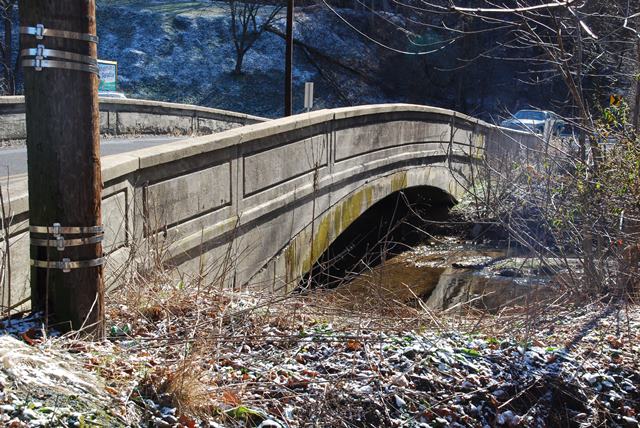We Recommend:
Bach Steel - Experts at historic truss bridge restoration.
BridgeHunter.com Phase 1 is released to the public! - Visit Now
Ironstone Bridge

Primary Photographer(s): Elaine Deutsch
Bridge Documented: 2016
Douglass: Berks County, Pennsylvania: United States
Not Available or Not Applicable
50.0 Feet (15.2 Meters)
50.0 Feet (15.2 Meters)
20 Feet (6.1 Meters)
1 Main Span(s)
5102

View Information About HSR Ratings
Bridge Documentation
This small concrete arch bridge is noted as a very early surviving example of its type in the region.
View Archived National Bridge Inventory Report - Has Additional Details and Evaluation
View Historic Bridge Inventory Sheet For This Bridge
View National Register of Historic Places Nomination Form For This Bridge
Information and Findings From Pennsylvania's Historic Bridge InventoryDiscussion of Bridge The single span, 50'-long reinforced concrete deck arch bridge is finished with concrete parapets with scored panels. The spandrel walls are plain save for scoring that accents the arch shape. The reinforced concrete deck arch bridge designed by the Berks County Engineer's Office was erected in 1907. The bridge is historically and technologically significant within the local context as a documented, early example of its type and design, which was used by Berks County with great frequency through the 1930s. It is one of 25 reinforced concrete deck arch bridges in the county dating from 1902 to 1936 and ranks as the second oldest extant example (criterion C). The use of reinforced concrete for closed spandrel arch bridges was introduced in this country about 1890. Although American engineers were familiar with a combination of concrete and reinforcing by about 1870, it took another 30 years of experimentation and theoretical and empirical investigations before engineers and builders had a mature understanding of the capabilities and versatility of the material. Once understood, the technology was quickly embraced, and by 1910, the elliptical-shaped, deck arch bridge, where the road is at or near the crown of the arch, was ubiquitous. Reinforced concrete arches offered an economical and relatively low maintenance alternative to steel truss bridges, and because of the moldable qualities of the material, the spandrel walls and railings could be architectonically detailed, frequently in the classical taste. The technology was immediately popular with some county and city engineers, and over 55 examples from before 1910 survive throughout the state. Over 200 examples from before 1916 survive, and 270 reinforced concrete closed spandrel arch bridges predate 1920. It is the early examples of the technology in the county like this one that represent its significance in the local and state context. The bridge is evaluated as individually significant. The significant boundary is the superstructure and substructure. Discussion of Surrounding Area The bridge carries a 2 lane road over a stream in a sparsely developed, rural area with scattered 20th-century residences and a waste water treatment plant. A railroad overpass is beyond the west side of the bridge. The area does not have historic district potential. Bridge Considered Historic By Survey: Yes |
This bridge is tagged with the following special condition(s): Unorganized Photos
![]()
Photo Galleries and Videos: Ironstone Bridge
Bridge Photo-Documentation
Original / Full Size PhotosA collection of overview and detail photos. This gallery offers photos in the highest available resolution and file size in a touch-friendly popup viewer.
Alternatively, Browse Without Using Viewer
![]()
Bridge Photo-Documentation
Mobile Optimized PhotosA collection of overview and detail photos. This gallery features data-friendly, fast-loading photos in a touch-friendly popup viewer.
Alternatively, Browse Without Using Viewer
![]()
Maps and Links: Ironstone Bridge
Coordinates (Latitude, Longitude):
Search For Additional Bridge Listings:
Bridgehunter.com: View listed bridges within 0.5 miles (0.8 kilometers) of this bridge.
Bridgehunter.com: View listed bridges within 10 miles (16 kilometers) of this bridge.
Additional Maps:
Google Streetview (If Available)
GeoHack (Additional Links and Coordinates)
Apple Maps (Via DuckDuckGo Search)
Apple Maps (Apple devices only)
Android: Open Location In Your Map or GPS App
Flickr Gallery (Find Nearby Photos)
Wikimedia Commons (Find Nearby Photos)
Directions Via Sygic For Android
Directions Via Sygic For iOS and Android Dolphin Browser
USGS National Map (United States Only)
Historical USGS Topo Maps (United States Only)
Historic Aerials (United States Only)
CalTopo Maps (United States Only)

